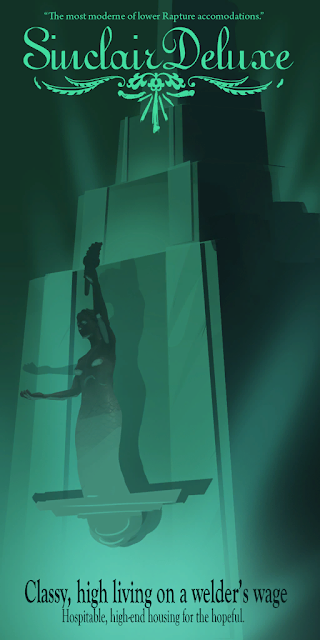Rapture City is a very rich art déco urban organism built by idealists and tied by a huge system of structures. Atlantic Express Company is the city metro which connect all the levels. Every station is an important place of the city which is called a ”level”. I want to show you the most important levels from the art déco perspective.
Ryan Amusements
― Carlson Fiddle
Ryan Amusements was a theme park built by Carlson Fiddle, intended to teach Andrew Ryan's philosophy to the youth of Rapture. Ryan realized after completion of the city that children, whether they immigrated to or were born in the city, might someday wish to leave Rapture seeking the surface world. Seeing that this would compromise Rapture's secrecy, he had a number of experts and consultants, the animatronics engineer Carlson Fiddle, Ryan's propaganda artist Sander Cohen and the psychiatrist Dr. Sofia Lamb, help design and build an educational theme park.
Pauper's Drop
― Grace Holloway
Even with its miserable appearance, Pauper's Drop was organized as a small town inside Rapture, housing several businesses and tenements. There were located the Fishbowl Diner and the Sinclair Deluxe in the area near the train station, several businesses for the poorest customers in Town Square, and a few others including a market in Skid Row. The Drop also featured Harold Parson's bookshop before it was closed down due to his propaganda against Andrew Ryan's policies.
Dionysus Park
― Sofia Lamb
Before the fall of Rapture, Dionysus Park was the private property of Sofia Lamb, and she meant for it to stand as a living example of her Collectivist ideals. Lamb felt that, despite Andrew Ryan's goal that artists in Rapture should "no longer fear the censor," he still censored the city's artists when he believed their public art ran contrary to his own ideals. Lamb created Dionysus Park as a safe haven where all artists could present their work unrestrained, and thus defy Ryan.
Fontain Futuristics
― Andrew Ryan
Fontaine Futuristics was established as a laboratory and business headquarters for Frank Fontaine's technological ventures in Rapture. His business once employed some of the brightest minds in Rapture, including doctors Brigid Tenenbaum, Yi Suchong, and Gilbert Alexander. After Frank Fontaine's "death" months prior to the 1958 New Year's Eve Riots, Andrew Ryan had the City take control of Fontaine Futuristics and placed under control of Ryan Industries.
Text by: Cătălin CREȚU
Source: Bioshock wikia
© The Bunget 2017

















Comments
Post a Comment